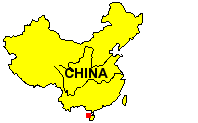| Hasho POW Camp |
Hainan Island
Main Page Main Camp List

|
Major camp was Hasho, [Basuo] on the west coast of the island.
Hainan is off the south coast of China. Following information supplied by Tom Pledger, [Corp, Australian Army, 2/12th Field Ambulance, attached to the 2/21st Inf Btn, Ambon], letters of 23 March 2000 and 9 Jul 2000. |
|
263 Australian and 245 Dutch Prisoners (508 total) from Ambon
were taken to port of Hasho, now called BASUO, a smaller city
adjacent to or part of the area about 5 miles west of DONGFANG
City on the west coast of Hainan. [Ship was the Taikio
[Taiko]Maru, departed 10 Oct 1942, 508 men, arrived
4 Nov 1942. Endured three days in typhoon. No deaths reported] Camp Description: I did not have to go out on the work parties, but was kept very busy in the camp, which consisted of 3 huts, 220 feet by 35 feet. No. 1 hut housed the Aussies, No. 2 the Dutch and No. 3 was the hospital. [see Pledger War Diary PDF] Camp Labor: Our main trouble was starvation, especially for the work parties as they had to march out about 7 AM and work all day and back about 6 PM. The first big job was building a ramp about 3/4 mile long from nothing up to about 60 feet high to carry about 6 sets of railway lines. [Fast loading Map of port showing ramp] This was so that the iron ore they were bring in by rail from the island could be loaded direct onto the ships. The guards were very cruel and beat the chaps with iron bars, pieces of thick timber, rifles and many had to be carried back to camp by their mates. Then we took over and did what we could for them, as we had no supplies, and the Japs gave us very, very little. [later jobs were mostly road building] The worst was when they got dysentery or beri-beri or malaria,
because the starvation diet they had no resistance to fight the
disease and many a chap I have held his hand and talked to him
so he would not die alone. |
|